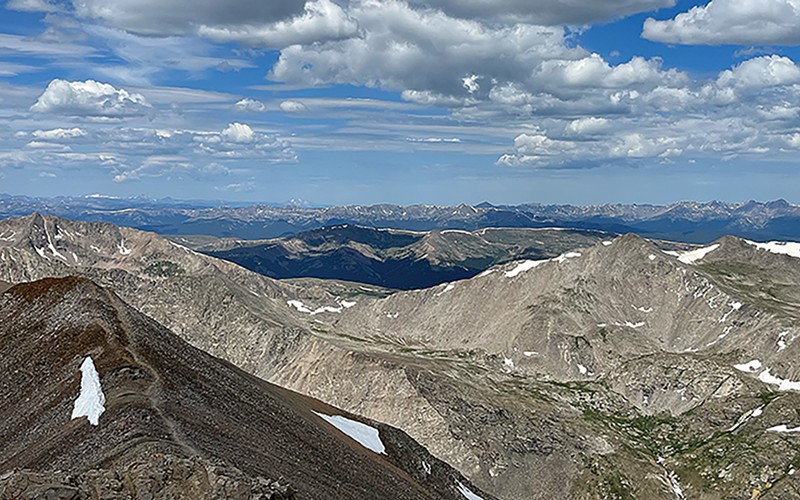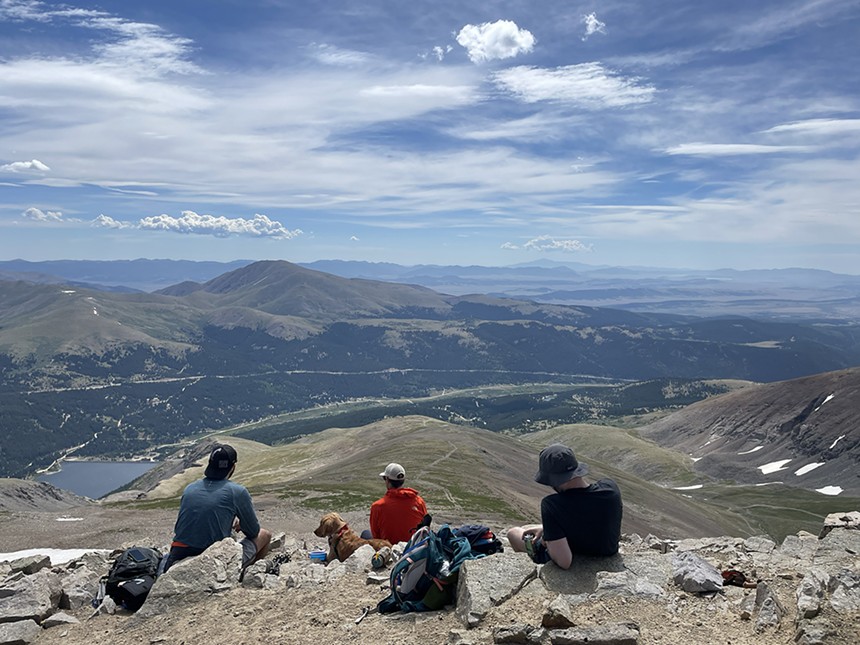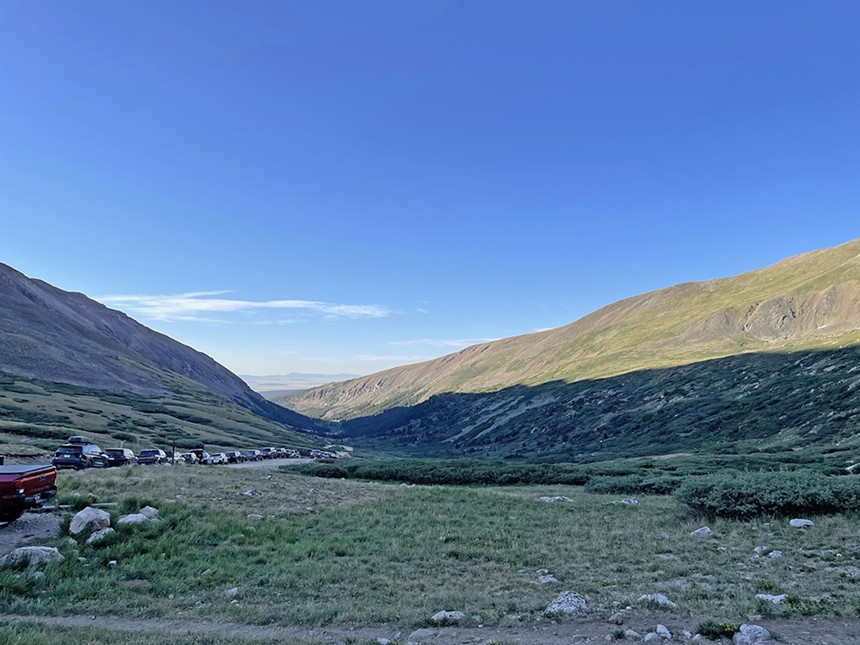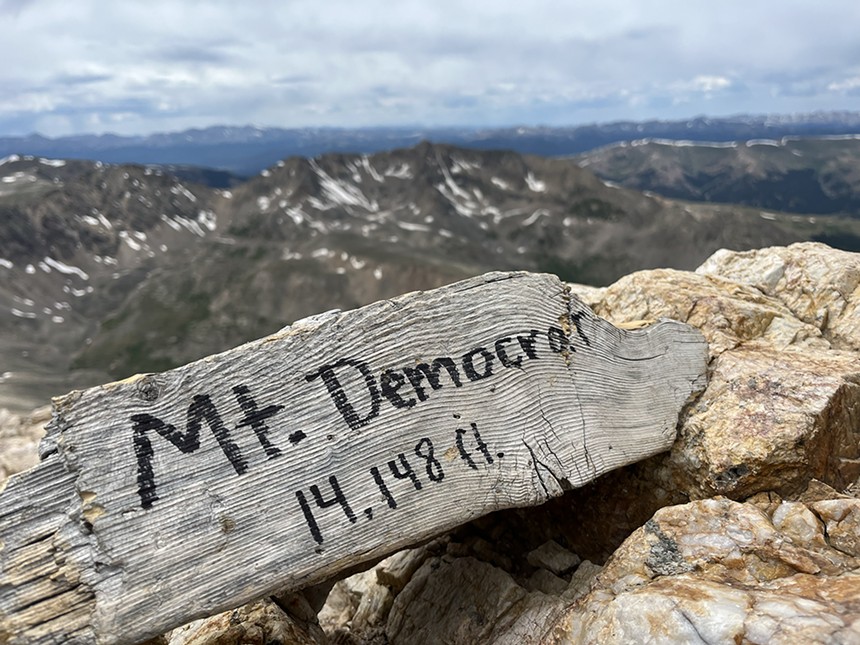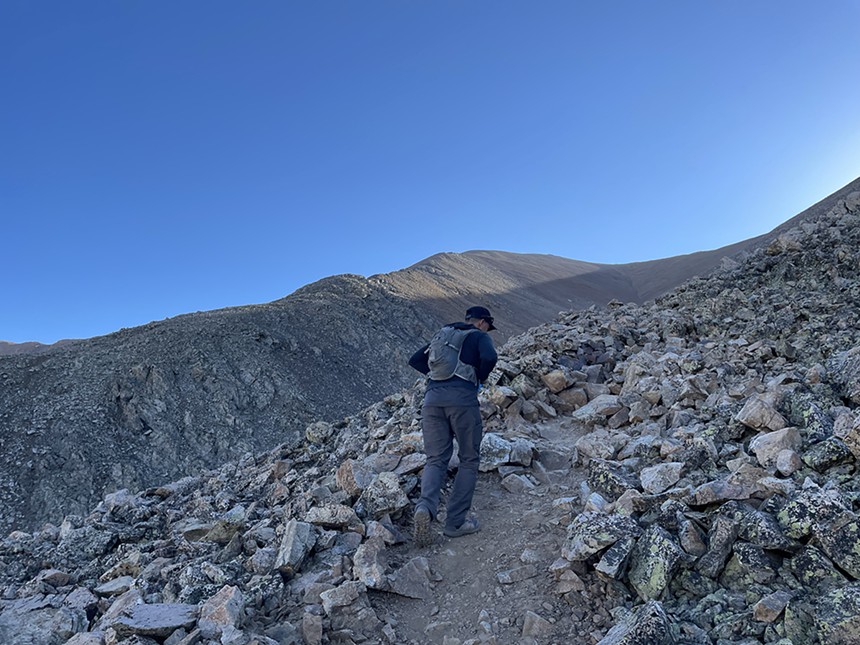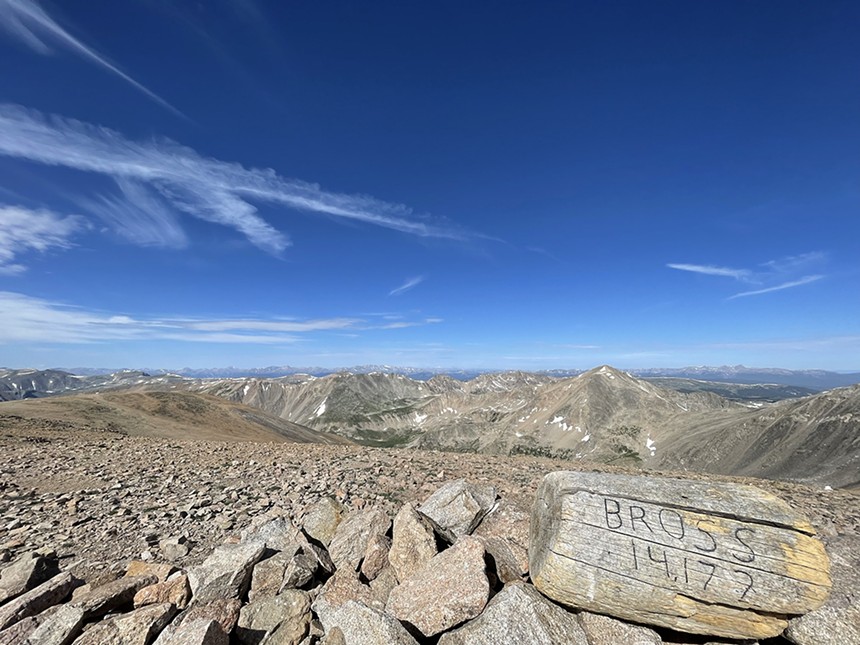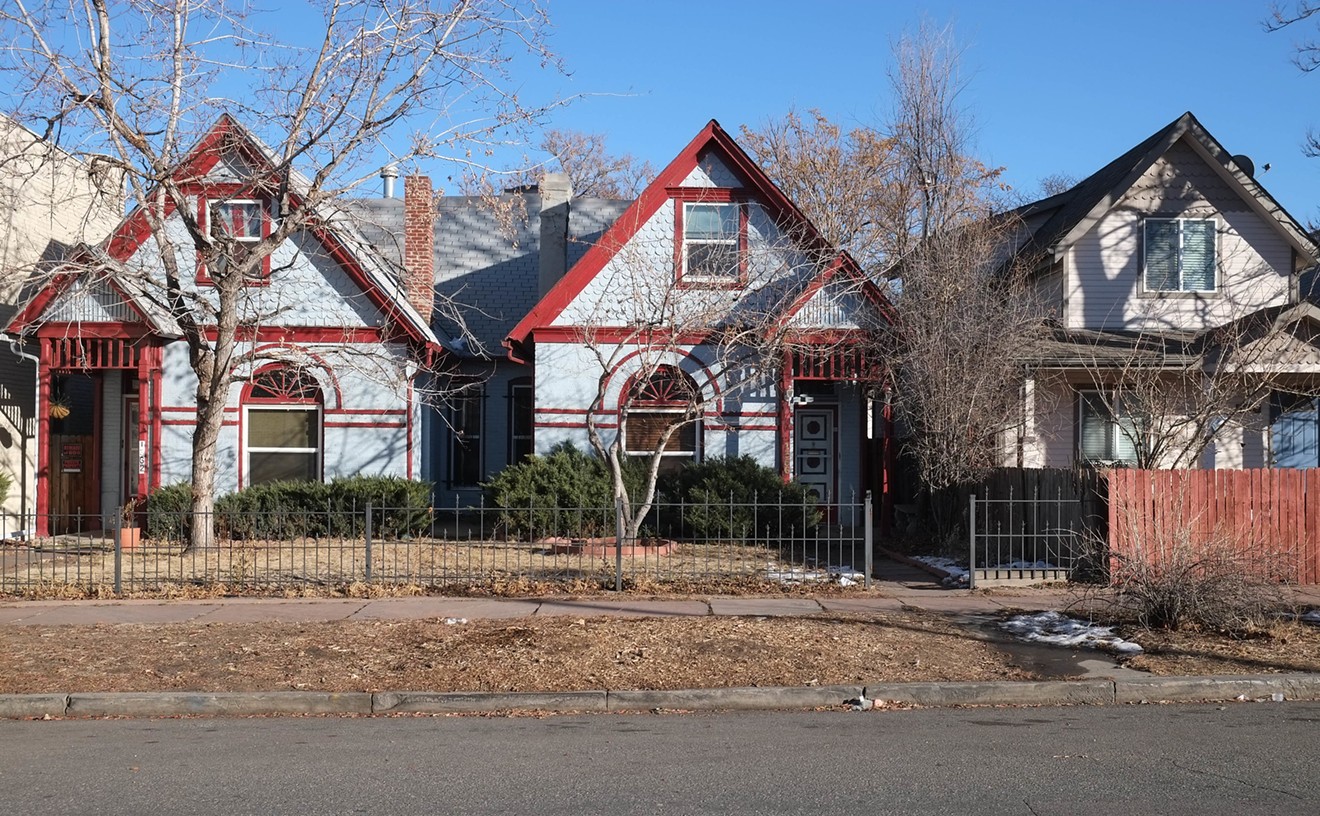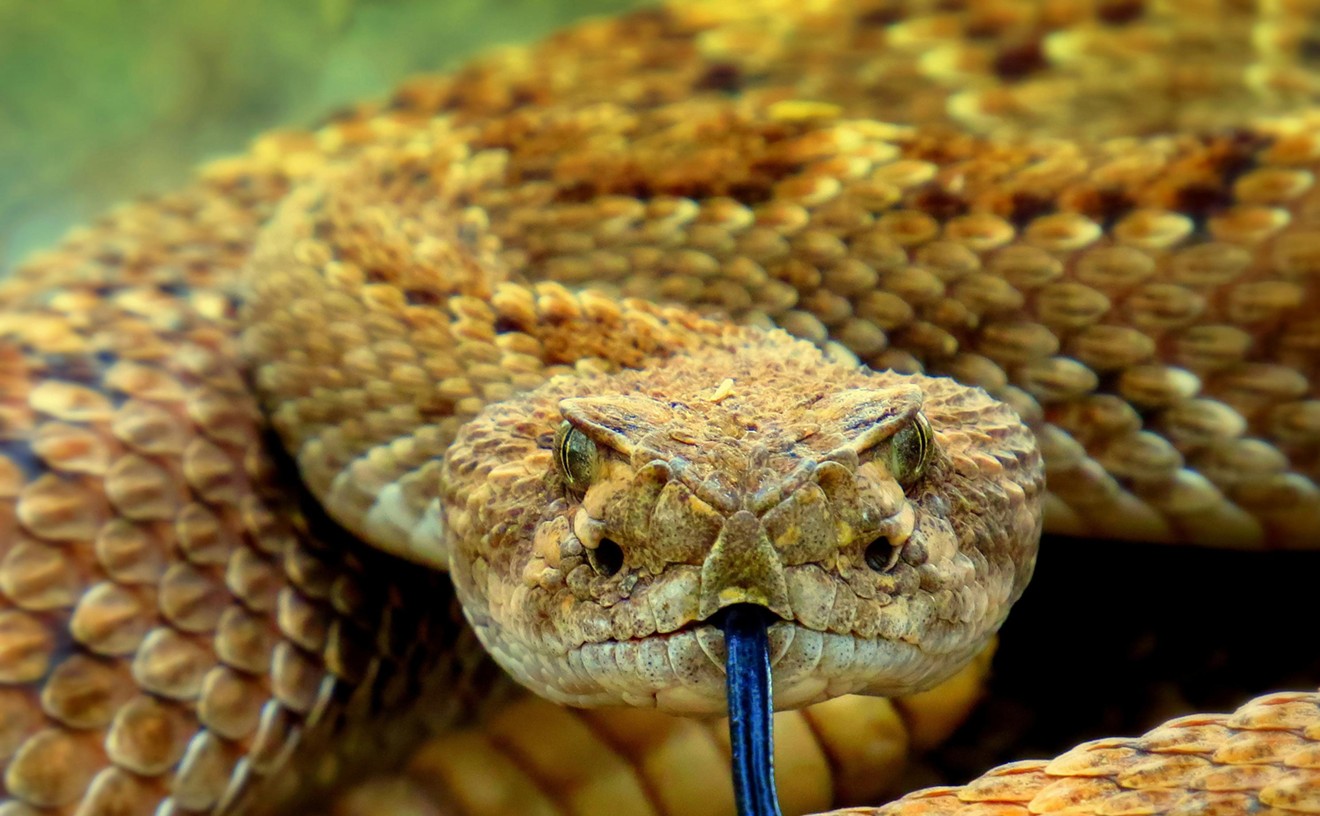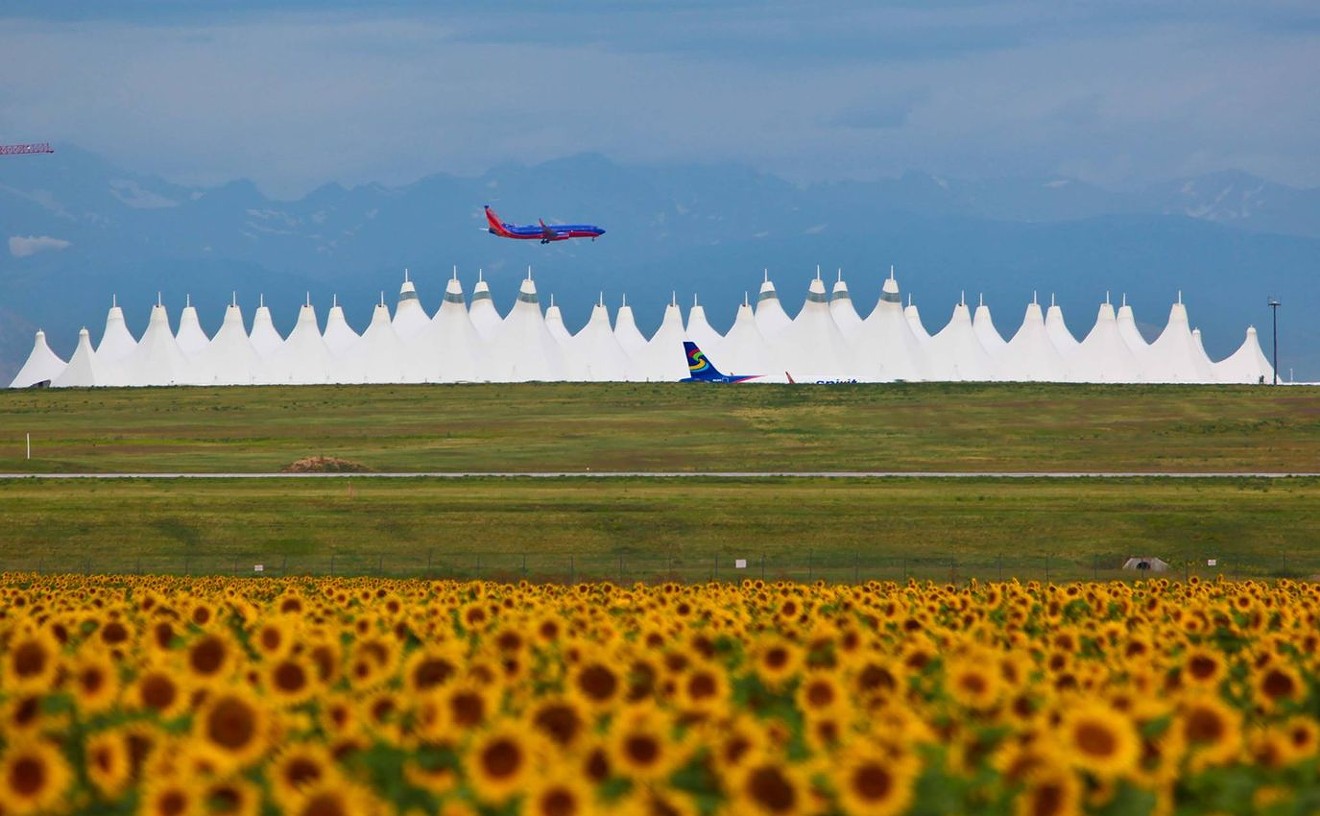About two weeks earlier, I'd written an article for Westword detailing how I'd gone to climb the newly opened Mount Democrat, Mount Lincoln and Mount Cameron the previous weekend, but wound up summiting the still-off-limits Mount Bross as well. My piece sparked a firestorm from hikers who worried that my actions would lead to the trails being closed again. They were calling for my head — or at least for me to be charged with trespassing.
"Number one, we don't go out there to check on people," McGraw told me. "Number two, on those types of charges, or those types of complaints, somebody has to make a complaint about it."
The owner of the property would have to press charges. And plenty of people were urging John Reiber to do just that.
In 1868, silver was discovered at the southern summit of what was then called Mount Lincoln, after the late president, by a trio of miners who found ore peeking out from the blue limestone. It took a few years to find investors willing to pay for equipment to chip away at the rocks and for burros to bring the silver down to nearby smelters, however.
In the meantime, the mountains of Colorado territory were attracting more than miners. There was another kind of rush to the Rockies: mountain climbers. Adventurers writing about their expeditions gave the 14,000-foot peaks a mystique that inspired the first generations of mountaineers.
One of the earliest recorded instances of summiting a mountain in what would become Colorado was documented by Edward James, a botanist and explorer. He'd joined the 1819-20 expedition led by Major Stephen Harriman Long into what was still largely unknown territory acquired in the Louisiana Purchase and wrote about climbing the "highest peak" — later named James Peak and then Pikes Peak, after Zebulon Pike, the military veteran who'd completed an expedition to the mountain earlier.
Another botanist, Charles Parry, made ascents to the tops of Front Range mountains in the 1860s. In 1861, he named two of the peaks after friends and fellow botanists Asa Gray and John Torrey. William Byers, founder and editor of the Rocky Mountain News, set out with Parry in 1864 to summit Longs Peak, named after the early explorer; though they failed, Byers wrote an account that was widely read in the growing frontier town of Denver.
Painter Albert Bierstadt was exploring Colorado's fourteeners in the 1860s as well. One of his favorite hikes was to the top of a 14,264-foot summit that he named Rosalie, after his wife, in 1863. In 1895, that peak was renamed Mount Evans, after Colorado's second territorial governor, John Evans. (Rosalie is now the name of a 13,575-foot peak southeast of Evans.)
Early tourists who had the interest and money usually went to one of four peaks: Pikes, Grays, Lincoln or Longs.
In 1868, journalist Samuel Bowles traveled to Mount Lincoln with politician Schuyler Colfax and William Bross, who was then the lieutenant governor of Illinois; he'd already founded the Chicago Tribune. He became so interested in the area that he invested in a thirteen-acre mining claim on Mount Lincoln, along with two other investors: painter Judson Dudley and New York businessman Andrew Gill.
In his book Mining Among the Clouds: The Mosquito Range and the Origins of Colorado's Silver Boom, author Harvey Gardiner notes that silver production in the state skyrocketed by 2,455 percent between 1871 and 1875.
The most productive of all the mines was Moose Mine, which burrowed into the southern summit of Mount Lincoln. This mine in particular "lay the foundation for Colorado's silver decade," Gardiner says. "It stands as one of Colorado's signal mineral discoveries and makes the Moose arguably the first great silver mine in the state."
The closest smelter to the base of Mount Lincoln was a camp set up by the Boston Smelting Company in 1873. For such a remote outpost, it was heavily populated, with as many as 10,000 people moving there by that December, when the camp successfully petitioned Park County to become the Town of Alma. More silver was discovered elsewhere on Mount Lincoln the next year, bringing more miners to Alma.
In 1876, William Bross returned to check on his claims; ultimately, the southern summit of Lincoln was named for him.
Today, the Colorado Geological Survey counts 58 qualified fourteeners in the state, including Mount Bross. (The U.S. Forest Service, which uses different measuring techniques, lists 56.) About 500,000 people are estimated to hike at least one fourteener in Colorado each year.
Colorado's fourteeners are spread across a handful of mountain ranges: The Sangre de Cristos and the San Juans account for most of them in the southern part of the state; the highest peak — Mount Elbert — is in the Sawatch Range in central Colorado; the most hiked fourteener — Mount Bierstadt — is on the Front Range, along with other popular peaks like Grays, Torreys and Evans. The most dangerous and rugged peaks are in the Elk Mountains, in the western part of the state.
And then there's the Mosquito Range, which has the distinction of being the most prosperous in mineral wealth. It includes Democrat, Cameron, Lincoln and Bross — the four peaks that make up the DeCaLiBron trail and account for its name — as well as Mount Sherman to the south and Quandary Peak just to the north. (Quandary is also considered part of the Tenmile Range because it's just across the Continental Divide from the DeCaLiBron peaks.)
While most of the fourteeners are on federal or state land, mining claims dating back more than a century keep some of the others private. In 2016, Mount Shavano was purchased by a nonprofit, the Colorado Fourteener Initiative, in order to keep it open to the public.
A dozen of Colorado's fourteeners are still privately owned, however, including Mount Princeton, Mount Sneffels, Castle Peak, Conundrum Peak, Wilson Peak (the one on the Coors Light can), Culebra Peak, Mount Lindsey, Mount Sherman and the DeCaLiBron peaks — except for Mount Cameron, which is federal land.
The 1872 U.S. Mining Act allowed miners to survey and claim public lands in Western states. Through this law, people can still have mining claims on Colorado's fourteeners today, which gives them the right to regulate access to their peaks. Some of these private fourteeners remain open for recreational use but have closed off areas near old mines or require liability waivers for those who venture onto the land.
Out of the privately owned fourteeners, two are completely off-limits to hikers: Mount Lindsey, in the Sangre de Cristo Range, and Mount Bross.
Billionaire hedge-fund manager Louis Bacon owns Mount Lindsey, along with the Blanca and Little Bear peaks; he closed Lindsey in 2021 in response to the James Nelson lawsuit filed against the U.S. Air Force.
Nelson was a bicyclist who plunged into an obscured culvert along an off-road trail at the U.S. Air Force Academy in Colorado Springs in 2008. Severely injured, he sued the AFA successfully for $7.3 million in a case that went on for eleven years, ending in 2019 and directly impacting access to fourteeners by proving that owners of recreational land could be held liable.
Hiking to the top of Culebra Peak requires crossing the Cielo Vista Ranch, which is owned by billionaire William Bruce Harrison. He bought the land and the peak in 2017 after inheriting a fortune made in Texas oil and gas. The Cielo Vista Ranch charges hikers $150 each to access the trail to Culebra Peak and only allows up to twenty hikers a day, strictly on weekends and just during the first seven months of the year.
Hikers who try to summit all of Colorado's fourteeners will sometimes use the acronym ABC to say they've hiked "all but Culebra," either to avoid the fee or to protest big-game hunting at Cielo Vista and the limitations put on climbers.
Athlete Erin Ton ran into trouble this year when she said she'd summited all 58 of Colorado's fourteeners in record time but actually only did 57: "all but Culebra."
Mount Bross's ownership is more complicated. Several people own mineral rights to the property, but because of his particular claims, one Park County man has the ability to open and close access to the DeCaLiBron trail that leads to its summit: John Reiber, a seventy-year-old retired utility executive and lifelong Fairplay resident.
Sheriff McGraw's contact lists him as "John Reiber. Owns Mountains."
Reiber's father, Maury, started buying mining claims in the Mosquito Range in the 1950s, "because that is an incredibly rich silver-mining area — and gold-mining area, but mostly silver," John Reiber says. "Up on Bross and Lincoln, both are high in silver."
He joined his father two decades later, and in 1988, the Reibers set up the company Earth Energy Resources to consolidate their claims under one entity.
The claims were always meant to be long-term investments. "The economics, I believe, will prove out to where it'll be time to reopen the mines," Reiber says. "All the properties I have are mining, zone mining and rural mines, and the reason we hold that is for the mineral potential of those properties. Now, whether I'll see it in my lifetime, I don't know. I don't know the answer to that.
"My father before me and I have spent eons of time just trying to put partial interest together to where we do own 100 percent," adds Reiber. "But Bross is not one that I've been able to acquire all interests in."
Instead, that peak is owned by "a variety of people," Reiber notes, who have small, sometimes inherited claims. Reiber once bought out a few Californians who collectively owned 2 percent of the mountain, which showed "how fine the ownership can get, where it's just a small amount of property that a group of folks own."
But the Reibers controlled access to Bross through the DeCaLiBron trail. In 2004, they owned all of the mining claims on Lincoln, and family friend Ben Wright owned those on Democrat. Worried about the increasing numbers of hikers on the trail, they closed access to the three DeCaLiBron peaks they controlled in order to avoid liability.
"The amount of opportunity for something to happen continued to get more and more likely all the time," Reiber recalls. "Back in the old days, when I was a kid, we'd go up there and we'd be working all day long. You might see four or five other people. You wouldn't see fifty or sixty or a hundred other people."
The move frustrated climbers who wanted to conquer all of Colorado's fourteeners. In 2006, State Representative Rob Witwer tried to get the trail reopened by proposing a revision to the 1977 Colorado Recreational Use Statute, or CRUS, the law that holds landowners liable for injuries on their land even if it's open to the public.
Witwer, a Republican from Jefferson County, did succeed in removing landowner liability in case anyone got hurt exploring mine shafts or other "attractive nuisances," but "the bill got watered such that actually, we were not satisfied with it," Reiber says.
In 2009, the nonprofit Colorado Fourteeners Initiative, which was founded in 1994 to preserve access to the peaks, got permission from the Reibers to construct a trail that took hikers away from their privately owned land and rerouted them through public land along safer parts of the property.
As a result, the Reibers and Wright opened up access to Lincoln and Democrat, with the provision that hikers stick to that trail. Bross remained closed, however.
Wright died in early 2010, and the Reibers bought his claims from his family. That put them in charge of Lincoln, Democrat and part of Bross. In 2014, Maury Reiber died, leaving all of his claims to his son.
After the Nelson lawsuit in 2019, Reiber's attorneys advised him that the case demonstrated he could still be successfully sued for heavy amounts. As a result, in 2021 Reiber again closed access to the rest of the DeCaLiBron peaks.
"The Air Force, as a government agency, probably $7.3 million wouldn't mean as much to them as it would to me," Reiber says. "I'd be bankrupt if I had to face something like that."
One of Reiber's primary concerns is Moose Mine. The mine is "huge," and its depths aren't entirely mapped, he says. It also "happens to be a very good example of how complex the shared ownership is," as thirteen different claims exist on the still-rich mine.
"I don't know where all the workings are, and that's what makes it scary," Reiber adds. "You don't know when it may or may not subside. I can't even tell you where all the areas of that mine go, because a lot of that work was done back in the 1800s."
But he does know that the ground under the Bross summit will cave in one day. "All ground will subside over time," he says.
"Even when my father was alive, we made that no trespassing because of the concerns for safety," he says. "Now, there's mines up on Democrat, there's mines up on Lincoln as well, but we have a little better understanding of those than we do of the Moose. That's why it's been no trespassing since 2004, and as long as I own it, it will stay no trespassing, just because of the safety issue.""Even when my father was alive, we made that no trespassing because of the concerns for safety."
tweet this
Last summer, Reiber reached a deal with the Town of Alma, the U.S. Forest Service, the CFI and other advocacy groups to reopen the trail on three of the DeCaLiBron peaks, with signs warning hikers to keep off Bross. Alma provided a lease that gave Reiber some level of governmental immunity from liability.
However, the deal was tenuous at best. Reiber says he really wanted an amendment to the CRUS that would remove any threat of liability.
Anneliese Steel, a public policy advocate with several groups, started lobbying Colorado lawmakers this year to pass a bill to amend a key clause in the CRUS.
The statute considers any injuries or deaths on private property that result from known dangers a "willful" failure. Steel and other advocates for open access to trails pushed SB23-103, a bill introduced during the last legislative session, that would have struck the word "willful" from the CRUS, among making other changes.
"Right now the standard is willful or malicious, and SB-103 struck 'willful' so it was only malicious, which is too low of a barrier," Steel says. "That doesn't provide enough consumer protections, and we saw that was why the Democratic Party said no."
In fact, the proposal didn't make it out of the Colorado Senate Judiciary Committee, which was heavily lobbied by the Colorado Trial Lawyers Association, according to Steel. The CTLA includes David Hersh, who'd sued the AFA on behalf of Nelson.
"They're not necessarily interested in fourteeners, they're not necessarily interested in outdoor access," Steel says. "The trial attorneys were the only opposition, and they did convince the entire Democratic Party to avoid the bill."
A couple of days after SB23-103 was killed on March 1, Reiber again closed the DeCaLiBron Loop. It stayed off-limits until July 28, when — after considerable lobbying by CFI and other groups — Reiber introduced a liability waiver that hikers are required to sign via a QR code at the entrance to the trail.
With that liability waiver in place, Reiber felt comfortable opening access to Lincoln, Democrat and Cameron, but he was unable to negotiate with the other owners of Bross to open that peak, too.
"I'm sure they're concerned about safety, just as I am," Reiber says. "They've never, ever come and said, 'Let's open it back up.'"
Steel is now the chair of the Fix CRUS Coalition, a group that formed in March to come up with another legislative proposal to revise the CRUS in a way that satisfies both landowners and the CTLA. It will be "much more narrowly crafted," she says, noting that State Representative Shannon Bird, a Democrat, plans to sponsor the bill.
"We're looking for a way that we can continue to increase protections for individuals, but not to a degree that makes landowners liable," Steel says. "The policy we're working on for 2024 is substantially different than what was presented in 2023."
In the meantime, the DeCaLiBron Loop is open...except for Bross.
I grew up in Aurora and climbed mountains all over Colorado with my father and his friends. On July 29, the day after the DeCaLiBron loop reopened, a friend and I headed to Hoosier Pass.
We'd left at four that morning, and by the time we passed Fairplay, the sun was up and the sky was clear blue, with chunky white clouds overhead. We reached the Kite Lake Trailhead, which is the starting point for the DeCaLiBron Loop. We'd committed to hiking at least one fourteener in the group, but hadn't decided which one it would be.
We could see that most hikers were doing the open portion of the DeCaLiBron Loop clockwise, in the order the peaks are listed: first Democrat, then Cameron, then Lincoln. The off-limits Bross is the fourth.
The problem with this route is that Democrat has a sheer face, and hiking it is like climbing over a massive pile of rock shards across a rugged, 1,500-foot slope. If we started there, we might not have the energy to make it to Lincoln, because Cameron is similarly challenging and exhausting.
And then, seeing that there were hikers on Bross, we decided to take the counterclockwise approach — going up the off-limits peak first. The face of Bross is also rugged with loose rocks and a steep incline, but it flattens out much more than Democrat does near the top.
Even so, we were straining for breath as we neared the summit, dirty with dry sweat and dust, bloody from hitting our shins and knees on jagged rocks, and hot from the rising sun peering over the ridge. But then we felt the rush of unbroken, pure air that you can only find on a high peak sweep down over us.
Refreshed, we went on to complete the entire loop, unsure when we'd get the chance to summit all of these fourteeners again.
When I'd told my Westword editors that I planned to climb the newly reopened peaks of the DeCaLiBron, they'd suggested I write an article about the experience. When I admitted I'd climbed the off-limits Bross, too, they said that I'd have to include that fact in my piece.
The response was rockier than the face of Bross.
"Like a Bross" went live on westword.com on August 2, and the responses came in fast...and furious.
The first comment was from Lloyd Athearn, executive director of the Colorado Fourteeners Initiative: "Seriously? You go up to the DeCaLiBron Loop intending to follow the rules for access, which have been hard fought to achieve by many of us."
I reach out to Athearn. "I'm pretty darn frustrated as someone who's been working for fifteen years to try to resolve private access issues to see your story and basically what I see as uninformed, entitled, arrogant," he tells me. "It sounded like you were going to do the right thing and then you saw other people doing stuff and you were like, 'Ah, the hell with it, why respect the closure?'"
My article "sends this crappy message to all these different landowners and to all of us who have been busting our ass for decades to try to make these peaks accessible," he adds.
CFI, which receives almost $2 million a year in contributions and grants, typically partners with the U.S. Forest Service and the Bureau of Land Management to build trails, protect animals and vegetation, and monitor the number of hikers going up fourteeners. But over the past few years, it's also been working hard to secure acccess.
"Most of what we do is physically building trails on fourteeners," Athearn says. "There's work you would have seen on the DeCaLiBron Loop when you were up there. Increasingly, because of the access issues, we've been involved in directly buying lands on the summit of Shavano so that the trail project could commence. We've been working with the Fix CRUS Coalition to try to resolve some of these private landowner liability concerns. We're trying in every way, shape or form to protect the mountains and allow people to recreate on them."
Athearn worked alongside Steel to push for changes to the CRUS at the legislature. After this spring's effort failed, CFI helped Reiber design the liability waiver system for the DeCaLiBron Loop that now allows hikers who sign it legal access to the trail. The nonprofit has also been trying to find ways to help Reiber cover the insurance premiums on his mining claims that have doubled in the last couple of years.
CFI has been trying to open discussions with Bacon about opening Lindsey as well, though Steel says the group hasn't had much luck reaching the billionaire. Convincing landowners to trust hikers is difficult, Athearn says. And I just made his job harder.
"People come from all over the globe to climb these mountains," Athearn explains. "The only way we get access to these things is either buy them or work with landowners and try to create a system whereby people can go climb them, and your actions make our work incredibly hard."
So hard that in addition to writing a rebuttal to my piece, members of the group had reached out to both Reiber and the sheriff about my trespassing on Mount Bross.
"You've been catching a lot of flak from a lot of organizations that are hikers," Sheriff McGraw says. "Your stance is basically to trespass and violate this man's property, and go up there to Bross."
McGraw's wife, son and daughter-in-law all hike fourteeners (though the sheriff, who worked in Florida for 35 years, not so much). His biggest concern was that my actions would compel Reiber to close the trail all over again.
That would hurt not just hikers, but the towns of Alma and Fairplay, which rely on tourism the way they used to rely on mining. "People come into the stores down there," McGraw notes. "They get some snacks they take up hiking, they walk through the town. So if you were to put a quash on hiking the fourteeners, it's going to hurt the town of Alma quite a bit."
Reiber, too, is concerned about economics — and losing what's dearest to him if he's sued.
"I would ask you this, Bennito," he says. "I don't know what your most prized possession may be. It may be your spouse. It may be your family. I don't know what. But look at the situation — especially after the Nelson case. ... The things I value the most, the security of my family, could be risked by somebody falling and then choosing to sue me."
Even if he won, "the cost just to defend myself would be very, very expensive," Reiber notes.
"This is not just a fourteeners issue. This is a private property issue. I know a lot of ranchers have issues with people crossing their land to go fishing or because it's a beautiful area," he adds.
"My concern is that a lot of people read your newspaper, and if it's good for one [to summit Bross], it's good for them, too," Reiber tells me. "That's why it really just wasn't a good thing for me, absolutely. As a matter of fact, I gave consideration to making the whole [DeCaLiBron trail] no trespassing again just because I don't want people thinking they can go where they want.""There are four fourteeners there, and a lot of people can see the goal, and they just want to do it."
tweet this
Although he condemns my act of trespassing, Reiber says he understands how I felt as I stood on the summit of Bross.
He used to love hiking fourteeners himself, especially when he was younger. "I've probably been to the top of Lincoln as much as anybody," he says.
"You're exactly right, there are four fourteeners there, and a lot of people can see the goal, and they just want to do it," Reiber concludes. "But my biggest concern, as I've said several times now, is safety. I probably won't change my attitude about that."
So far, Reiber hasn't chosen to press charges. Without that, McGraw says, it would be difficult for him to build an investigation, but "you're a little different because you made it so public."
McGraw had contacted Linda Stanley, the 11th Judicial District Attorney, and asked: "What do you think? Do you think I have a decent case?"
"Well, the simple news article itself is not going to be enough to charge him," McGraw says she told him. "You're going to have to have a little bit more. The pictures themselves are pretty good."
I could have given McGraw a statement beyond the story itself, and "all that information would have been used to possibly put a charge on you," he says. A simple trespassing charge could carry a fine of $50 to $100...more for a repeat violator. But jail was unlikely.
And it really depended on whether Reiber was willing to push it. "He was wanting to see where you were going to go with this whole thing," McGraw concludes. "It sounds to me that you're wanting to go in the right direction, so we're not going to worry about this. You're not in a tremendous amount of trouble."
But the DeCaLiBron Loop could be if more follow my lead.

